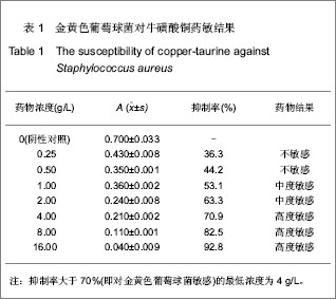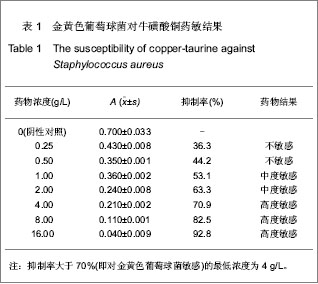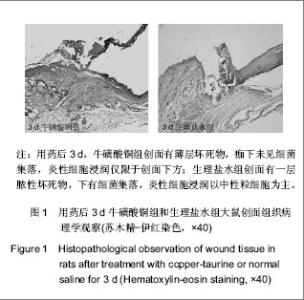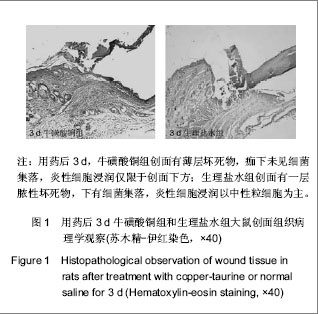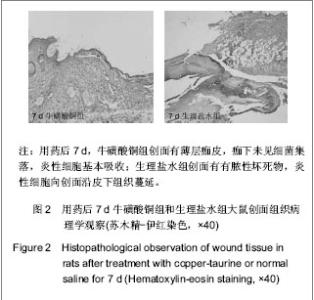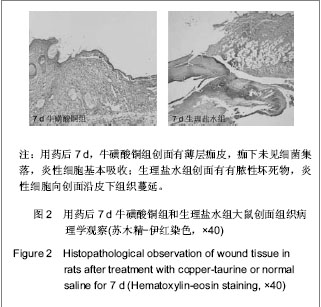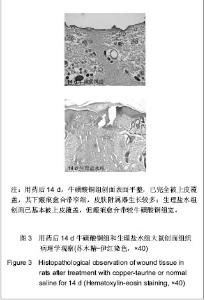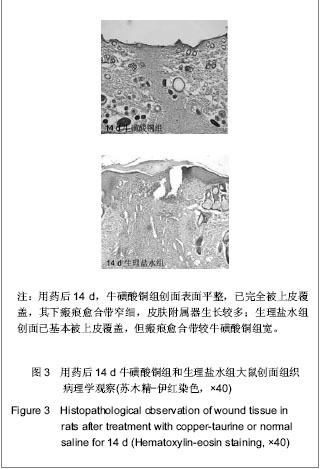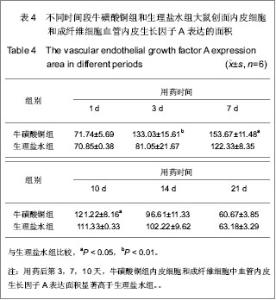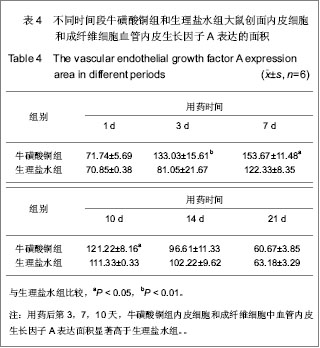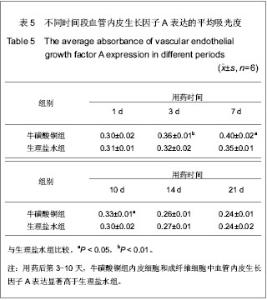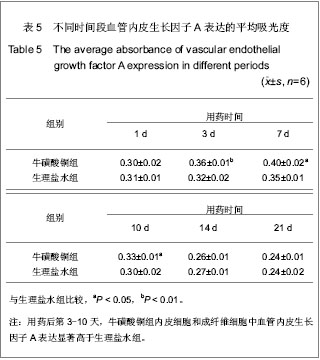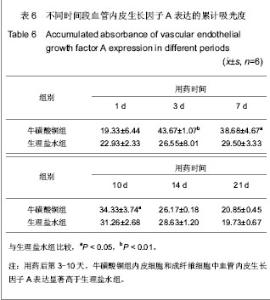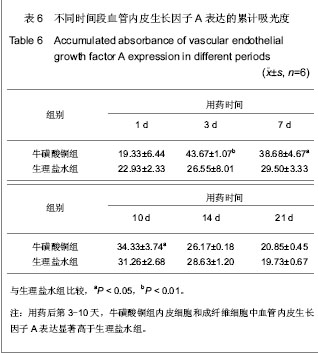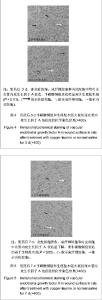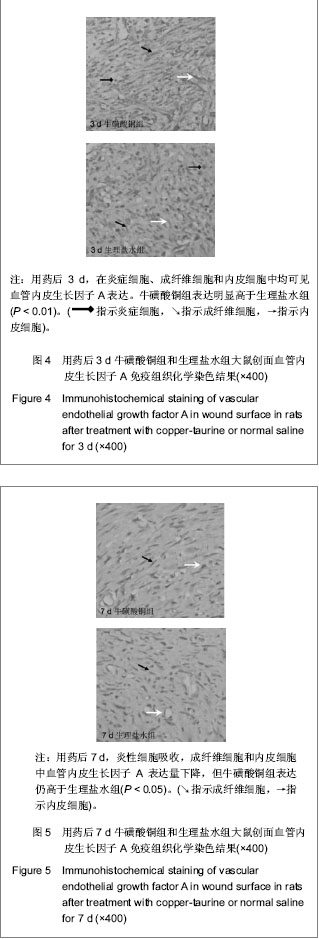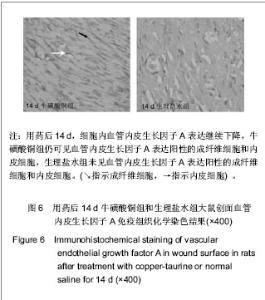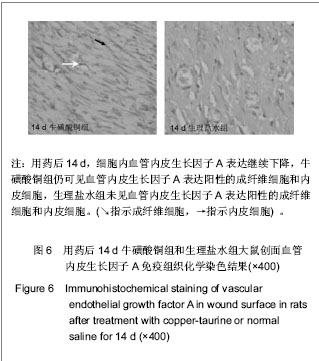Chinese Journal of Tissue Engineering Research
Previous Articles Next Articles
Copper-taurine regulates vascular endothelial growth factor A expression during infected wound healing process in rats
Wang Shou-yu, Tian Xi-liang, Lü De-cheng
- Department of Orthopedics, the First Affiliated Hospital of Dalian Medical University, Dalian 116011, Liaoning Province, China
-
Received:2012-09-22Revised:2012-10-16Online:2013-05-21Published:2013-05-21 -
Contact:Wang Shou-yu☆, M.D., Associate professor, Department of Orthopedics, the First Affiliated Hospital of Dalian Medical University, Dalian 116011, Liaoning Province, China. wangshouyu666.student@sina.com -
About author:Lü De-cheng, Professor, Chief physician, Department of Orthopedics, the First Affiliated Hospital of Dalian Medical University, Dalian 116011, Liaoning Province, China lvdecheng88@sina.com -
Supported by:the National Natural Science Foundation of China, No. 30901950
CLC Number:
Cite this article
Wang Shou-yu, Tian Xi-liang, Lü De-cheng. Copper-taurine regulates vascular endothelial growth factor A expression during infected wound healing process in rats[J]. Chinese Journal of Tissue Engineering Research, doi: 10.3969/j.issn.2095-4344.2013.21.021.
share this article
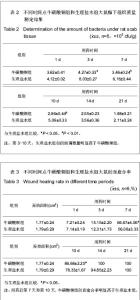
2.2 两组大鼠创面痂下菌量 表2显示的是不同时间点两组大鼠创面每克痂下组织的细菌含量。可见用药后第3天,生理盐水组创面细菌大量繁殖,数量明显高于牛磺酸铜组,差异有非常显著性意义(P < 0.01)。用药后第7-10天,生理盐水组创面细菌数量有所下降,但仍高于牛磺酸铜组(P < 0.05)。用药后第14-21天,两组创面基本被瘢痕组织覆盖,细菌数量都明显下降,相差无显著性意义(P > 0.05)。 2.3 两组大鼠创面愈合率的比较 见表3。牛磺酸铜组创面愈合要好于生理盐水组:用药后第7天和第10天,牛磺酸铜组创面愈合率分别为(66.67±4.06)%和(86.68±2.25)%,明显高于生理盐水组(56.08±3.33)%和(78.33±1.67)%(P < 0.05)。其他时间点两组创面愈合率比较差异无显著性意义(P > 0.05)。牛磺酸铜组创面的平均愈合时间为(13.3±0.8) d,低于生理盐水组的(16.6± 2.2) d,但两组比较差异无显著性意义(P > 0.05)。"
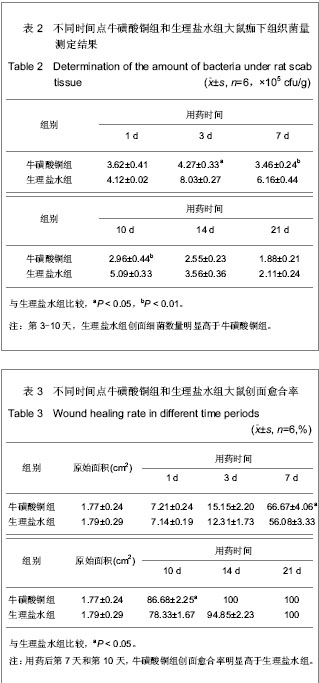
| [1] Monaco JL, Lawrence WT. Acute wound healing: An overview. Clinics in Plastic Surgery.2003; 30(1): 1-12.[2] Whitney JD. Overview: Acute and Chronic Wounds. Nursing Clinics of North America.2005; 40(2): 191-205.[3] Williams RL, Sroussi HY, Abercrombie JJ, et al. Synthetic decapeptide reduces bacterial load and accelerates healing in the wounds of restraint-stressed mice. Brain, Behavior, and Immunity.2012; 26(4):588-596.[4] Tian X, Zhang Z, Wang S ,et al. Copper–taurine (CT): A potential organic compound to facilitate infected wound healing. Medical Hypotheses.2009; 73(6):1048-1050. [5] de Romaña DL, Olivares M, Uauy R, et al. Risks and benefits of copper in light of new insights of copper homeostasis. Journal of Trace Elements in Medicine and Biology. 2011; 25(1): 3-13.[6] Zhang NL,Liu JH,Sun FC.Shijie Yuansu Yixue. 2007,14(1): 41-43.张奶玲,刘景华,孙凤春.铜与人体健康的关系[J].世界元素医学, 2007,14(1): 41-43.[7] Hou JY,Hu XD.Siliao Yanjiu. 2010;1: 39-40.侯江泳,胡向东. 微量元素铜在动物机体中的作用研究进展[J].饲料研究, 2010,1: 39-40.[8] Shen J,Jiang QY,Zhong GQ.Huagong Jinzhan. 2006;6: 634-638.沈娟,蒋琪英,钟国清.牛磺酸配合物的合成与应用研究进展[J].化工进展, 2006,6: 634-638.[9] Dang DB, An B, Niu WJ, et al. Assembly of one novel polyoxometalate-based inorganic–organic compound from copper-Schiff base building block: Synthesis, crystal structure and spectral properties. Spectrochimica Acta Part A: Molecular and Biomolecular Spectroscopy. 2012; 91: 338-344.[10] Chattopadhyay T, Kogiso M, Asakawa M, et al. Copper(II)-coordinated organic nanotube: A novel heterogeneous catalyst for various oxidation reactions. Catalysis Communications. 2010;1(25) : 9-13.[11] Doan K, Bronaugh RL, Yourick JJ. In vivo and in vitro skin absorption of lipophilic compounds, dibutyl phthalate, farnesol and geraniol in the hairless guinea pig. Food and Chemical Toxicology. 2010; 48(1): 18-23. [12] NCCLS/CLIS.Performence standards for antimicrobial susceptibility testing [M]. Fifteenth Inform Suppl.M100-S15, 2005:44-52.[13] Uppal SK, Ram S, Kwatra B, et al.Comparative evaluation of surface swab and quantitative full thickness wound biopsy culture in burn patients. Burns. 2007; 33(4): 460-463.[14] Liu ZZ,Chen ZG,Sun TZ,et al.Zhongguo Meirong Yixue. 2009; 18(3):328-331.刘丈忠,陈志刚,孙同柱,等. 大鼠深Ⅱ度烫伤创面愈合中血管形成与血流变化特点[J]. 中国美容医学,2009,18(3):328-331.[15] Park E, Lee SM, Jung IK,et al. Effects of genistein on early-stage cutaneous wound healing. Biochem Biophys Res Commun. 2011; 410(3): 514-519.[16] Lehtola MJ, Miettinen IT, Keinänen MM, et al.Microbiology, chemistry and biofilm development in a pilot drinking water distribution system with copper and plastic pipes. Water Research. 2004; 38(17): 3769-3779.[17] Borkow G, Gabbay J. Copper as a biocidal tool. Curr Med Chem. 2005; 12:2163-2175.[18] Borkow G, Zatcoff RC, Gabbay J.Reducing the risk of skin pathologies in diabetics by using copper impregnated socks. Medical Hypotheses. 2009; 73(6): 883-886.[19] Sen CK, Khanna S, Venojarvi M, et al.Copper-induced vascular endothelial growth factor expression and wound healing.Am J Physiol Heart Circ Physiol.2002; 282(5): H1821-H1827. [20] Lansdown AB.Metallothioneins: potential therapeutic aids for wound healing in the skin. Wound Repair Regen. 2002; 10:130-132.[21] Mel'nikova VI, Izvol'skaia MS, Voronova SN,et al. Reparative regeneration of rat skin under influence of hollow cathode lamp (HCL) with manganese and copper line spectrum emission. Tsitologiia. 2010; 52(3):204-210.[22] Abe K,Matsuki N.Measurement of cellular 3-(4,5-dimethylthiazol-2-yl)-2,5-diphenyltetrazolium bromide (MTT) reduction activity and lactate dehydrogenase release using MTT. Neurosci. Res.2000; 38(4):325-329.[23] Hamid R, Rotshteyn Y, Rabadi L, et al. Comparison of Alamar blue and MTT assays for high through-put screening. Toxicol. In Vitro. 2004; 18(5): 703-710.[24] Zhou LG.Beijing:Zhongguo Nongye Kexue Jishu Chubanshe. 2005: 63-85.周立刚.植物抗菌化合物[M].北京:中国农业科学技术出版社, 2005: 63-85. |
| [1] | Pu Rui, Chen Ziyang, Yuan Lingyan. Characteristics and effects of exosomes from different cell sources in cardioprotection [J]. Chinese Journal of Tissue Engineering Research, 2021, 25(在线): 1-. |
| [2] | Yuan Jiawei, Zhang Haitao, Jie Ke, Cao Houran, Zeng Yirong. Underlying targets and mechanism of Taohong Siwu Decoction in prosthetic joint infection on network pharmacology [J]. Chinese Journal of Tissue Engineering Research, 2021, 25(9): 1428-1433. |
| [3] | Hou Jingying, Yu Menglei, Guo Tianzhu, Long Huibao, Wu Hao. Hypoxia preconditioning promotes bone marrow mesenchymal stem cells survival and vascularization through the activation of HIF-1α/MALAT1/VEGFA pathway [J]. Chinese Journal of Tissue Engineering Research, 2021, 25(7): 985-990. |
| [4] | Hua Haotian, Zhao Wenyu, Zhang Lei, Bai Wenbo, Wang Xinwei. Meta-analysis of clinical efficacy and safety of antibiotic artificial bone in the treatment of chronic osteomyelitis [J]. Chinese Journal of Tissue Engineering Research, 2021, 25(6): 970-976. |
| [5] | Jiang Xin, Qiao Liangwei, Sun Dong, Li Ming, Fang Jun, Qu Qingshan. Expression of long chain non-coding RNA PGM5-AS1 in serum of renal transplant patients and its regulation of human glomerular endothelial cells [J]. Chinese Journal of Tissue Engineering Research, 2021, 25(5): 741-745. |
| [6] | Li Xingping, Xiao Dongqin, Zhao Qiao, Chen Shuo, Bai Yiguang, Liu Kang, Feng Gang, Duan Ke. Preparation and properties of copper-loaded antibacterial functional film on titanium surface [J]. Chinese Journal of Tissue Engineering Research, 2021, 25(4): 553-557. |
| [7] | Li Li, Ma Li. Immobilization of lactase on magnetic chitosan microspheres and its effect on enzymatic properties [J]. Chinese Journal of Tissue Engineering Research, 2021, 25(4): 576-581. |
| [8] | Shi Xiaoxiu, Mao Shilong, Liu Yang, Ma Xingshuang, Luo Yanfeng. Comparison of tantalum and titanium (alloy) as orthopedic materials: physical and chemical indexes, antibacterial and osteogenic ability [J]. Chinese Journal of Tissue Engineering Research, 2021, 25(4): 593-599. |
| [9] | Zhang Zhenkun, Li Zhe, Li Ya, Wang Yingying, Wang Yaping, Zhou Xinkui, Ma Shanshan, Guan Fangxia. Application of alginate based hydrogels/dressings in wound healing: sustained, dynamic and sequential release [J]. Chinese Journal of Tissue Engineering Research, 2021, 25(4): 638-643. |
| [10] | Ma Rui, Wang Jialin, Wu Mengjun, Ge Ying, Wang Wei, Wang Kunzheng. Relationship of pathogenic bacteria distribution with drug resistance and treatment cycle for periprosthetic joint infection after total joint arthroplasty [J]. Chinese Journal of Tissue Engineering Research, 2021, 25(3): 380-385. |
| [11] | Jiang Tao, Ma Lei, Li Zhiqiang, Shou Xi, Duan Mingjun, Wu Shuo, Ma Chuang, Wei Qin. Platelet-derived growth factor BB induces bone marrow mesenchymal stem cells to differentiate into vascular endothelial cells [J]. Chinese Journal of Tissue Engineering Research, 2021, 25(25): 3937-3942. |
| [12] | Liu Jinwei, Chen Yunzhen, Wan Chunyou. Changes of osteogenic growth factors in the broken end of bone nonunion under stress [J]. Chinese Journal of Tissue Engineering Research, 2021, 25(23): 3619-3624. |
| [13] | Liu Fang, Shan Zhengming, Tang Yulei, Wu Xiaomin, Tian Weiqun. Effects of hemostasis and promoting wound healing of ozone sustained-release hydrogel [J]. Chinese Journal of Tissue Engineering Research, 2021, 25(22): 3445-3449. |
| [14] | Chen Siqi, Xian Debin, Xu Rongsheng, Qin Zhongjie, Zhang Lei, Xia Delin. Effects of bone marrow mesenchymal stem cells and human umbilical vein endothelial cells combined with hydroxyapatite-tricalcium phosphate scaffolds on early angiogenesis in skull defect repair in rats [J]. Chinese Journal of Tissue Engineering Research, 2021, 25(22): 3458-3465. |
| [15] | Zhou Anqi, Tang Yufei, Wu Bingfeng, Xiang Lin. Designing of periosteum tissue engineering: combination of generality and individuality [J]. Chinese Journal of Tissue Engineering Research, 2021, 25(22): 3551-3557. |
| Viewed | ||||||
|
Full text |
|
|||||
|
Abstract |
|
|||||
